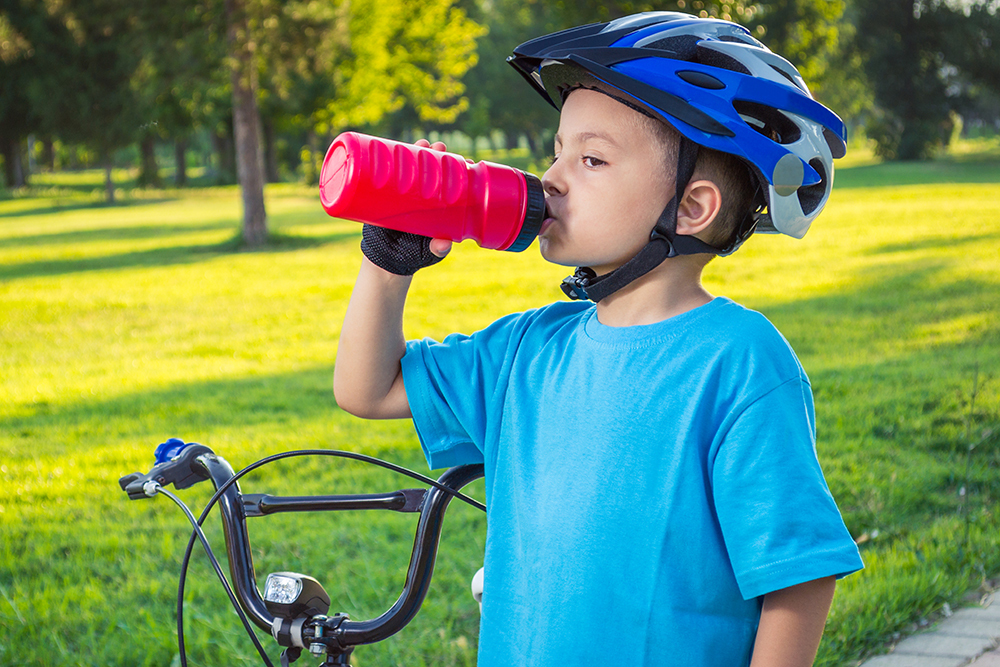It's always important for kids to meet their daily fluid needs. Water is found abundantly in the brain, heart, lungs, skin, and even bones. The vital nutrient helps control body temperature, supports healthy digestion, brings wastes out of the body, prevents constipation, and much more. Keep reading to learn how much water your kid should drink, with tips for staying hydrated throughout the day.
How Much Water Should Kids Drink?
As the saying goes, you can lead a child to water, but you can't make them drink. The amount of liquid your kid needs depends on their weight and physical activity. But according to the American Academy of Pediatrics (AAP), "children ages 1-3 years need approximately 4 cups of beverages per day, including water or milk. This increases for older kids to around 5 cups for 4-8 year olds, and 7-8 cups for older children."
Note that most of your child's fluid intake should be water, and the amount will increase in warmer months. When it's hot outside, or if your child is very active and sweating, be sure they are sipping additional water at least every 20 minutes.

Encourage Your Child to Drink More Water
When they're busy playing, your child won't want to stop and drink water. Here are some tips for encouraging proper hydration.
Always have liquids available. Take water bottles with you when you leave the house, and offer your child something to sip during moments of stillness, such as screen time and car rides.
Model proper hydration yourself. When kiddos see Mom or Dad consistently reaching for water, they will be more inclined to do the same.
Get educated. You might also try reading them a book like Drinking Water, by Mari C. Schuh, which explains why their body needs water.
Mix it up. Enhance the taste of plain water by adding a small splash of 100 percent fruit juice, or squeezing the juice of a slice of lemon, lime, orange or grapefruit into it. You can also add some fresh or frozen berries, cucumber slices, or mint to give plain water some bite.
Eat hydrating foods. Your child does not need to get their liquids exclusively from, well, liquids. Juicy fruits like watermelon and berries, fruit and veggie pouches, vegetables like cucumbers, and healthy fruit ice pops can all help your little one get hydrated.
Limit juice and soda intake. Try to keep fruit juices and electrolyte drinks to a minimum, and dilute them with water, because they contain a lot of sugar. Also avoid drinks that have caffeine, such as iced tea or many sodas, because caffeine is a diuretic that can contribute to the dehydration process by increasing fluid loss. In addition, as a stimulant, caffeine can depress the symptoms of dehydration.
Buy special drinking supplies. It's also helpful to let your child pick out their own special cup, water bottle, or silly straw.
Watch for Signs of Dehydration
Children are more prone to dehydration than adults because their bodies don't cool down as efficiently, and the summer heat increases the risk. The danger arises when fluids are leaving the body through sweating faster than they are being replaced, and severe dehydration can be life-threatening.
A good sign of proper hydration is light-yellow or clear urine. Darker urine, decreased urine, dry skin, chapped lips, and no tears when crying can all be signs of dehydration. By the time your child simply feels thirsty, they may already be dehydrated, so do your best to stay ahead of the situation. Kids get rehydrated pretty quickly; if you're worried your child is dehydrated, offer them small sips of fluids frequently.
You should visit the emergency room or call 911 if your child experiences extreme lethargy, unresponsiveness, vomiting, lack of sweat, and severe abdominal pain.
Parts of this article originally appeared in Parents magazine's July 2021 issue as "How to Keep Your Child Hydrated." Want more from the magazine? Sign up for a monthly print subscription here
Parents magazine































